Analyzing Newcastle United FC Player Performance with BI Tools
VerifiedAdded on 2023/01/11
|8
|2425
|62
Project
AI Summary
This project examines the declining performance of Newcastle United Football Club (NUFC) by analyzing player data using business intelligence (BI) and data analytics. The report identifies the issue as a problem/opportunity statement, focusing on player performance parameters such as goals, wins, losses, and positions played over two seasons. The theory applied revolves around BI and data analytics, utilizing Microsoft Excel and dashboard tools to visualize player data. The methodology involves data handling, data mining, and visualization to analyze player performance trends. The critical analysis and justification of the developed dashboard highlights how the data is presented through slicers and charts, enabling the assessment of individual player performance and the overall team performance. The conclusion recommends using clustering, regression, and correlation to identify the exact reasons for low player motivation and owner interest. The project suggests enhancing player fees and hiring more talented players to improve NUFC's performance. The project provides a comprehensive analysis of NUFC's player performance using BI tools and offers strategic recommendations for improvement.

Players
Paraphrase This Document
Need a fresh take? Get an instant paraphrase of this document with our AI Paraphraser
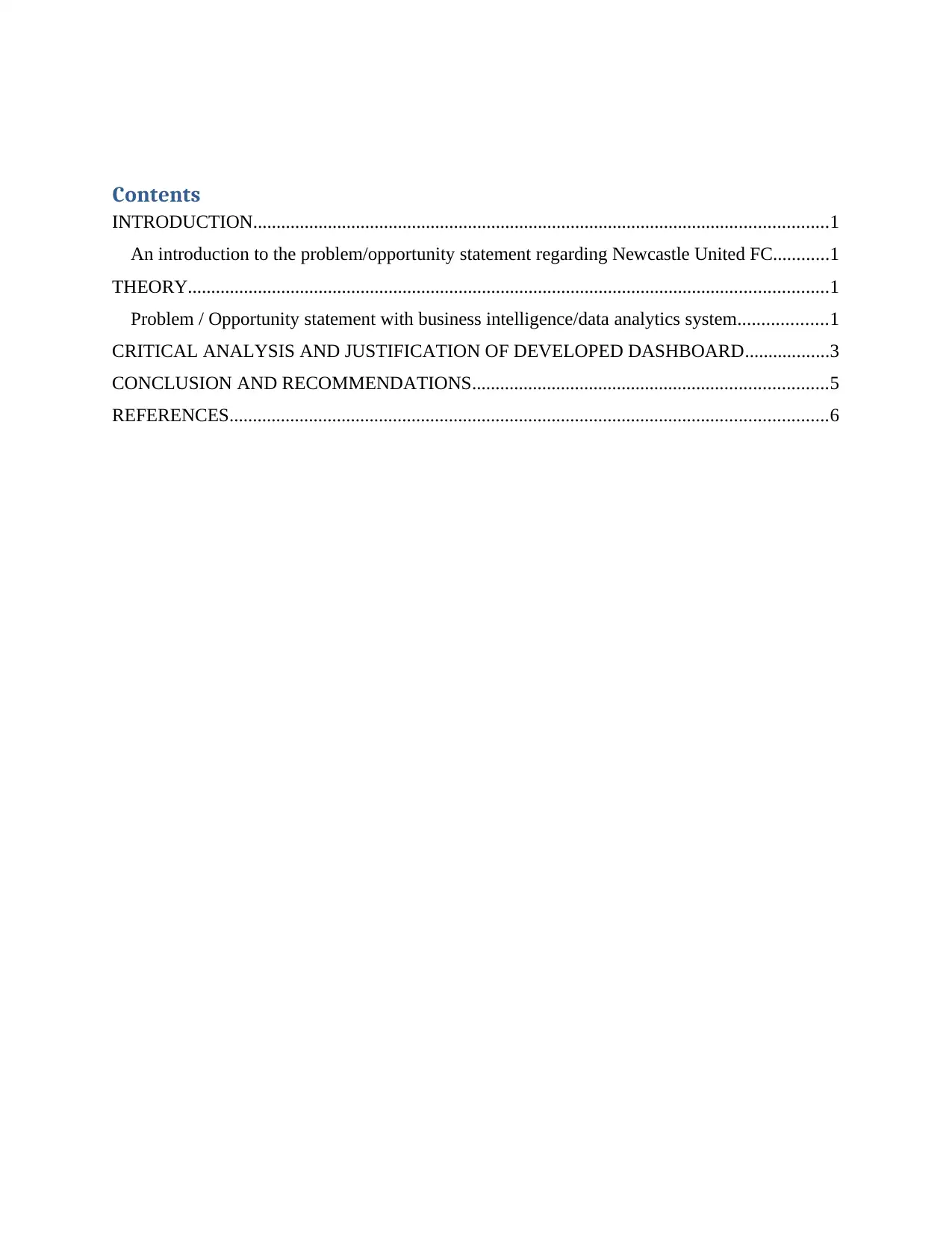
Contents
INTRODUCTION...........................................................................................................................1
An introduction to the problem/opportunity statement regarding Newcastle United FC............1
THEORY.........................................................................................................................................1
Problem / Opportunity statement with business intelligence/data analytics system...................1
CRITICAL ANALYSIS AND JUSTIFICATION OF DEVELOPED DASHBOARD..................3
CONCLUSION AND RECOMMENDATIONS............................................................................5
REFERENCES................................................................................................................................6
INTRODUCTION...........................................................................................................................1
An introduction to the problem/opportunity statement regarding Newcastle United FC............1
THEORY.........................................................................................................................................1
Problem / Opportunity statement with business intelligence/data analytics system...................1
CRITICAL ANALYSIS AND JUSTIFICATION OF DEVELOPED DASHBOARD..................3
CONCLUSION AND RECOMMENDATIONS............................................................................5
REFERENCES................................................................................................................................6
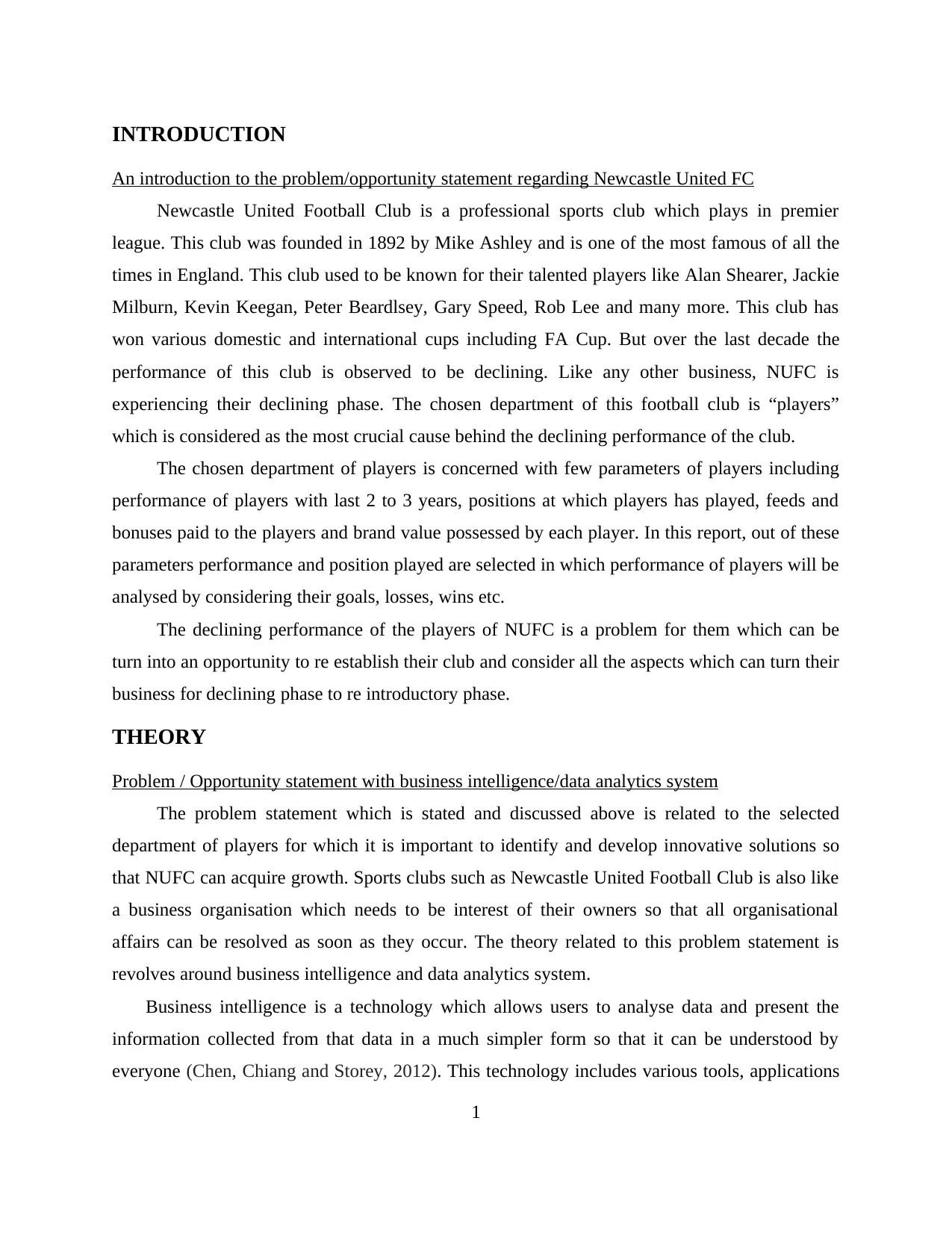
INTRODUCTION
An introduction to the problem/opportunity statement regarding Newcastle United FC
Newcastle United Football Club is a professional sports club which plays in premier
league. This club was founded in 1892 by Mike Ashley and is one of the most famous of all the
times in England. This club used to be known for their talented players like Alan Shearer, Jackie
Milburn, Kevin Keegan, Peter Beardlsey, Gary Speed, Rob Lee and many more. This club has
won various domestic and international cups including FA Cup. But over the last decade the
performance of this club is observed to be declining. Like any other business, NUFC is
experiencing their declining phase. The chosen department of this football club is “players”
which is considered as the most crucial cause behind the declining performance of the club.
The chosen department of players is concerned with few parameters of players including
performance of players with last 2 to 3 years, positions at which players has played, feeds and
bonuses paid to the players and brand value possessed by each player. In this report, out of these
parameters performance and position played are selected in which performance of players will be
analysed by considering their goals, losses, wins etc.
The declining performance of the players of NUFC is a problem for them which can be
turn into an opportunity to re establish their club and consider all the aspects which can turn their
business for declining phase to re introductory phase.
THEORY
Problem / Opportunity statement with business intelligence/data analytics system
The problem statement which is stated and discussed above is related to the selected
department of players for which it is important to identify and develop innovative solutions so
that NUFC can acquire growth. Sports clubs such as Newcastle United Football Club is also like
a business organisation which needs to be interest of their owners so that all organisational
affairs can be resolved as soon as they occur. The theory related to this problem statement is
revolves around business intelligence and data analytics system.
Business intelligence is a technology which allows users to analyse data and present the
information collected from that data in a much simpler form so that it can be understood by
everyone (Chen, Chiang and Storey, 2012). This technology includes various tools, applications
1
An introduction to the problem/opportunity statement regarding Newcastle United FC
Newcastle United Football Club is a professional sports club which plays in premier
league. This club was founded in 1892 by Mike Ashley and is one of the most famous of all the
times in England. This club used to be known for their talented players like Alan Shearer, Jackie
Milburn, Kevin Keegan, Peter Beardlsey, Gary Speed, Rob Lee and many more. This club has
won various domestic and international cups including FA Cup. But over the last decade the
performance of this club is observed to be declining. Like any other business, NUFC is
experiencing their declining phase. The chosen department of this football club is “players”
which is considered as the most crucial cause behind the declining performance of the club.
The chosen department of players is concerned with few parameters of players including
performance of players with last 2 to 3 years, positions at which players has played, feeds and
bonuses paid to the players and brand value possessed by each player. In this report, out of these
parameters performance and position played are selected in which performance of players will be
analysed by considering their goals, losses, wins etc.
The declining performance of the players of NUFC is a problem for them which can be
turn into an opportunity to re establish their club and consider all the aspects which can turn their
business for declining phase to re introductory phase.
THEORY
Problem / Opportunity statement with business intelligence/data analytics system
The problem statement which is stated and discussed above is related to the selected
department of players for which it is important to identify and develop innovative solutions so
that NUFC can acquire growth. Sports clubs such as Newcastle United Football Club is also like
a business organisation which needs to be interest of their owners so that all organisational
affairs can be resolved as soon as they occur. The theory related to this problem statement is
revolves around business intelligence and data analytics system.
Business intelligence is a technology which allows users to analyse data and present the
information collected from that data in a much simpler form so that it can be understood by
everyone (Chen, Chiang and Storey, 2012). This technology includes various tools, applications
1
⊘ This is a preview!⊘
Do you want full access?
Subscribe today to unlock all pages.

Trusted by 1+ million students worldwide
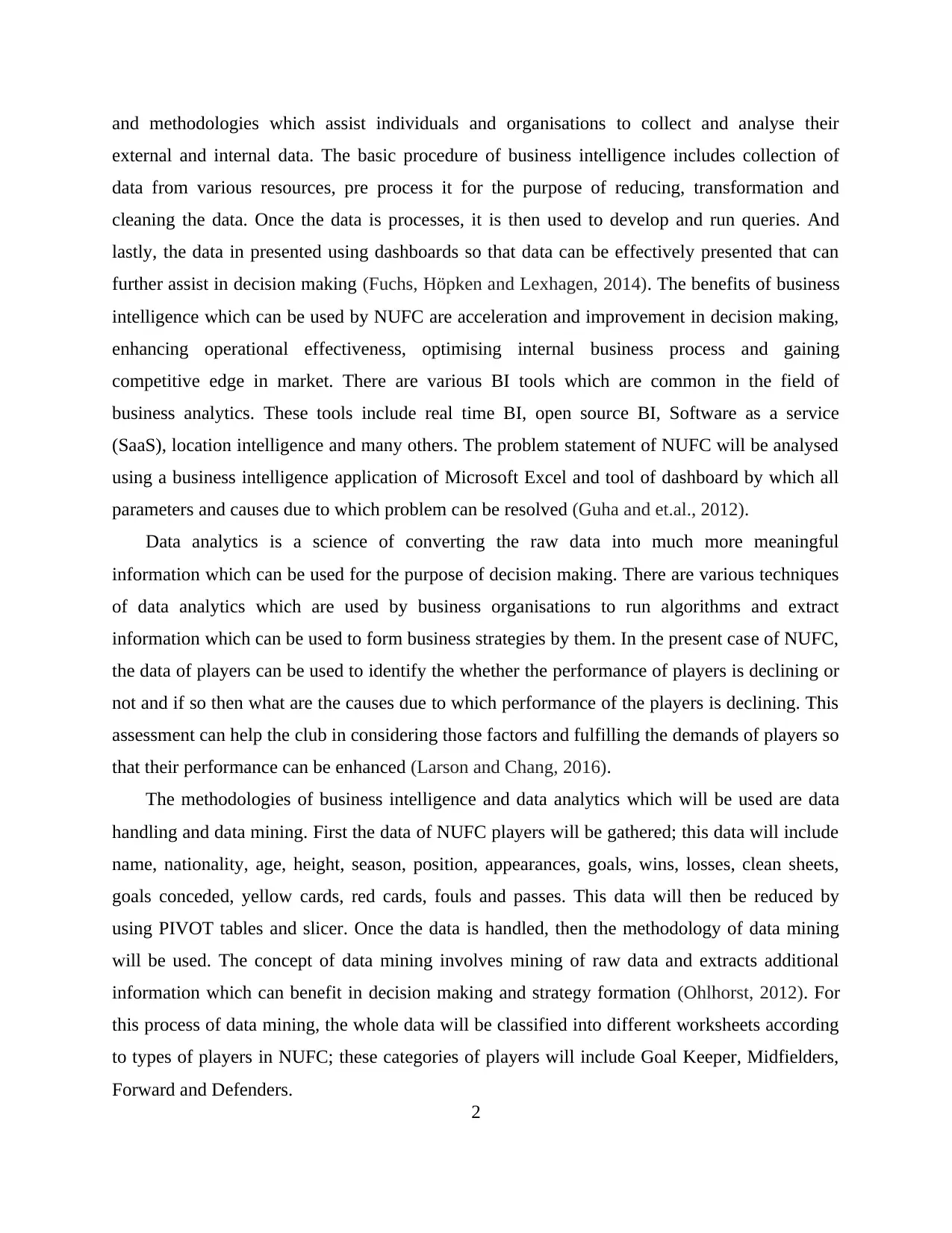
and methodologies which assist individuals and organisations to collect and analyse their
external and internal data. The basic procedure of business intelligence includes collection of
data from various resources, pre process it for the purpose of reducing, transformation and
cleaning the data. Once the data is processes, it is then used to develop and run queries. And
lastly, the data in presented using dashboards so that data can be effectively presented that can
further assist in decision making (Fuchs, Höpken and Lexhagen, 2014). The benefits of business
intelligence which can be used by NUFC are acceleration and improvement in decision making,
enhancing operational effectiveness, optimising internal business process and gaining
competitive edge in market. There are various BI tools which are common in the field of
business analytics. These tools include real time BI, open source BI, Software as a service
(SaaS), location intelligence and many others. The problem statement of NUFC will be analysed
using a business intelligence application of Microsoft Excel and tool of dashboard by which all
parameters and causes due to which problem can be resolved (Guha and et.al., 2012).
Data analytics is a science of converting the raw data into much more meaningful
information which can be used for the purpose of decision making. There are various techniques
of data analytics which are used by business organisations to run algorithms and extract
information which can be used to form business strategies by them. In the present case of NUFC,
the data of players can be used to identify the whether the performance of players is declining or
not and if so then what are the causes due to which performance of the players is declining. This
assessment can help the club in considering those factors and fulfilling the demands of players so
that their performance can be enhanced (Larson and Chang, 2016).
The methodologies of business intelligence and data analytics which will be used are data
handling and data mining. First the data of NUFC players will be gathered; this data will include
name, nationality, age, height, season, position, appearances, goals, wins, losses, clean sheets,
goals conceded, yellow cards, red cards, fouls and passes. This data will then be reduced by
using PIVOT tables and slicer. Once the data is handled, then the methodology of data mining
will be used. The concept of data mining involves mining of raw data and extracts additional
information which can benefit in decision making and strategy formation (Ohlhorst, 2012). For
this process of data mining, the whole data will be classified into different worksheets according
to types of players in NUFC; these categories of players will include Goal Keeper, Midfielders,
Forward and Defenders.
2
external and internal data. The basic procedure of business intelligence includes collection of
data from various resources, pre process it for the purpose of reducing, transformation and
cleaning the data. Once the data is processes, it is then used to develop and run queries. And
lastly, the data in presented using dashboards so that data can be effectively presented that can
further assist in decision making (Fuchs, Höpken and Lexhagen, 2014). The benefits of business
intelligence which can be used by NUFC are acceleration and improvement in decision making,
enhancing operational effectiveness, optimising internal business process and gaining
competitive edge in market. There are various BI tools which are common in the field of
business analytics. These tools include real time BI, open source BI, Software as a service
(SaaS), location intelligence and many others. The problem statement of NUFC will be analysed
using a business intelligence application of Microsoft Excel and tool of dashboard by which all
parameters and causes due to which problem can be resolved (Guha and et.al., 2012).
Data analytics is a science of converting the raw data into much more meaningful
information which can be used for the purpose of decision making. There are various techniques
of data analytics which are used by business organisations to run algorithms and extract
information which can be used to form business strategies by them. In the present case of NUFC,
the data of players can be used to identify the whether the performance of players is declining or
not and if so then what are the causes due to which performance of the players is declining. This
assessment can help the club in considering those factors and fulfilling the demands of players so
that their performance can be enhanced (Larson and Chang, 2016).
The methodologies of business intelligence and data analytics which will be used are data
handling and data mining. First the data of NUFC players will be gathered; this data will include
name, nationality, age, height, season, position, appearances, goals, wins, losses, clean sheets,
goals conceded, yellow cards, red cards, fouls and passes. This data will then be reduced by
using PIVOT tables and slicer. Once the data is handled, then the methodology of data mining
will be used. The concept of data mining involves mining of raw data and extracts additional
information which can benefit in decision making and strategy formation (Ohlhorst, 2012). For
this process of data mining, the whole data will be classified into different worksheets according
to types of players in NUFC; these categories of players will include Goal Keeper, Midfielders,
Forward and Defenders.
2
Paraphrase This Document
Need a fresh take? Get an instant paraphrase of this document with our AI Paraphraser
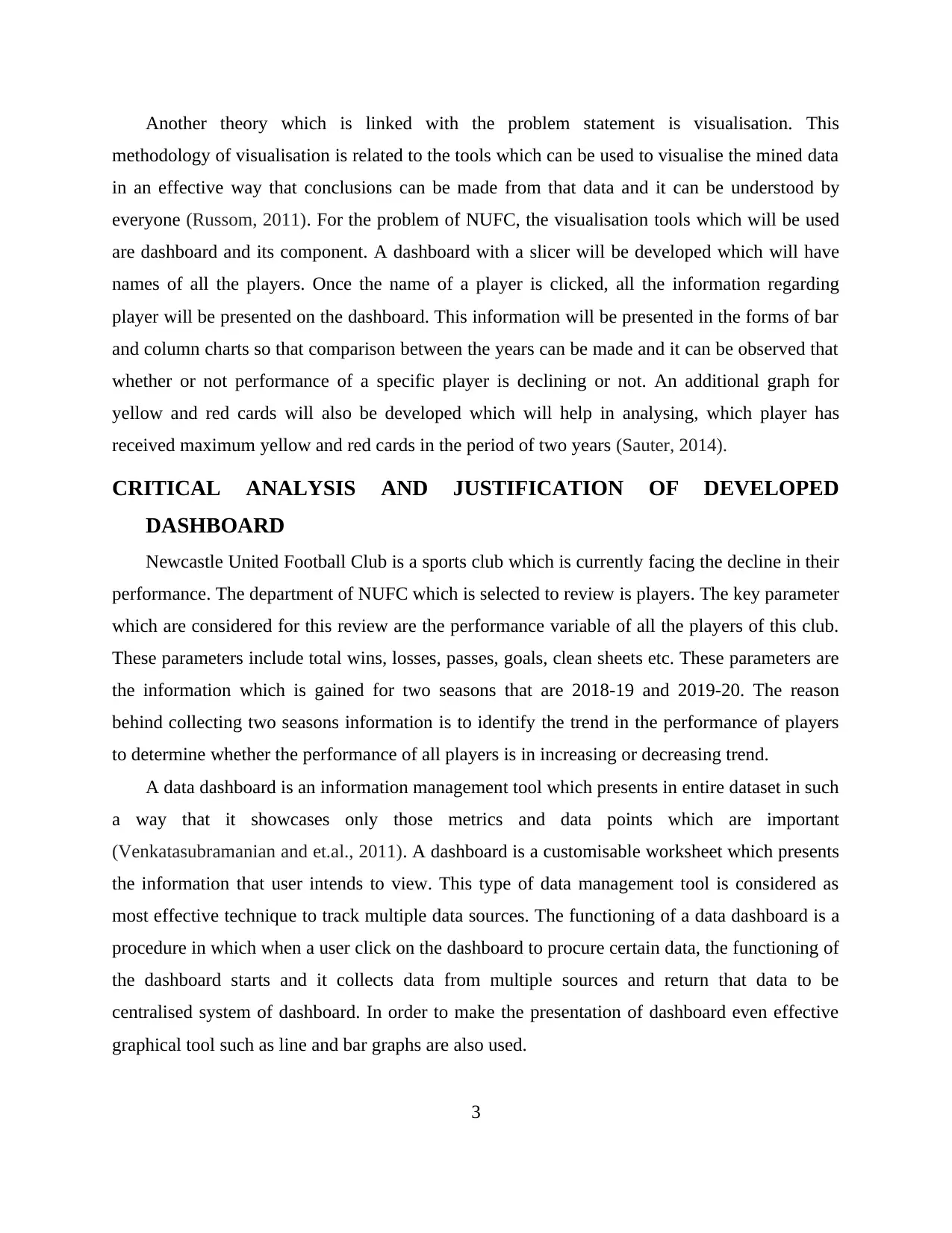
Another theory which is linked with the problem statement is visualisation. This
methodology of visualisation is related to the tools which can be used to visualise the mined data
in an effective way that conclusions can be made from that data and it can be understood by
everyone (Russom, 2011). For the problem of NUFC, the visualisation tools which will be used
are dashboard and its component. A dashboard with a slicer will be developed which will have
names of all the players. Once the name of a player is clicked, all the information regarding
player will be presented on the dashboard. This information will be presented in the forms of bar
and column charts so that comparison between the years can be made and it can be observed that
whether or not performance of a specific player is declining or not. An additional graph for
yellow and red cards will also be developed which will help in analysing, which player has
received maximum yellow and red cards in the period of two years (Sauter, 2014).
CRITICAL ANALYSIS AND JUSTIFICATION OF DEVELOPED
DASHBOARD
Newcastle United Football Club is a sports club which is currently facing the decline in their
performance. The department of NUFC which is selected to review is players. The key parameter
which are considered for this review are the performance variable of all the players of this club.
These parameters include total wins, losses, passes, goals, clean sheets etc. These parameters are
the information which is gained for two seasons that are 2018-19 and 2019-20. The reason
behind collecting two seasons information is to identify the trend in the performance of players
to determine whether the performance of all players is in increasing or decreasing trend.
A data dashboard is an information management tool which presents in entire dataset in such
a way that it showcases only those metrics and data points which are important
(Venkatasubramanian and et.al., 2011). A dashboard is a customisable worksheet which presents
the information that user intends to view. This type of data management tool is considered as
most effective technique to track multiple data sources. The functioning of a data dashboard is a
procedure in which when a user click on the dashboard to procure certain data, the functioning of
the dashboard starts and it collects data from multiple sources and return that data to be
centralised system of dashboard. In order to make the presentation of dashboard even effective
graphical tool such as line and bar graphs are also used.
3
methodology of visualisation is related to the tools which can be used to visualise the mined data
in an effective way that conclusions can be made from that data and it can be understood by
everyone (Russom, 2011). For the problem of NUFC, the visualisation tools which will be used
are dashboard and its component. A dashboard with a slicer will be developed which will have
names of all the players. Once the name of a player is clicked, all the information regarding
player will be presented on the dashboard. This information will be presented in the forms of bar
and column charts so that comparison between the years can be made and it can be observed that
whether or not performance of a specific player is declining or not. An additional graph for
yellow and red cards will also be developed which will help in analysing, which player has
received maximum yellow and red cards in the period of two years (Sauter, 2014).
CRITICAL ANALYSIS AND JUSTIFICATION OF DEVELOPED
DASHBOARD
Newcastle United Football Club is a sports club which is currently facing the decline in their
performance. The department of NUFC which is selected to review is players. The key parameter
which are considered for this review are the performance variable of all the players of this club.
These parameters include total wins, losses, passes, goals, clean sheets etc. These parameters are
the information which is gained for two seasons that are 2018-19 and 2019-20. The reason
behind collecting two seasons information is to identify the trend in the performance of players
to determine whether the performance of all players is in increasing or decreasing trend.
A data dashboard is an information management tool which presents in entire dataset in such
a way that it showcases only those metrics and data points which are important
(Venkatasubramanian and et.al., 2011). A dashboard is a customisable worksheet which presents
the information that user intends to view. This type of data management tool is considered as
most effective technique to track multiple data sources. The functioning of a data dashboard is a
procedure in which when a user click on the dashboard to procure certain data, the functioning of
the dashboard starts and it collects data from multiple sources and return that data to be
centralised system of dashboard. In order to make the presentation of dashboard even effective
graphical tool such as line and bar graphs are also used.
3
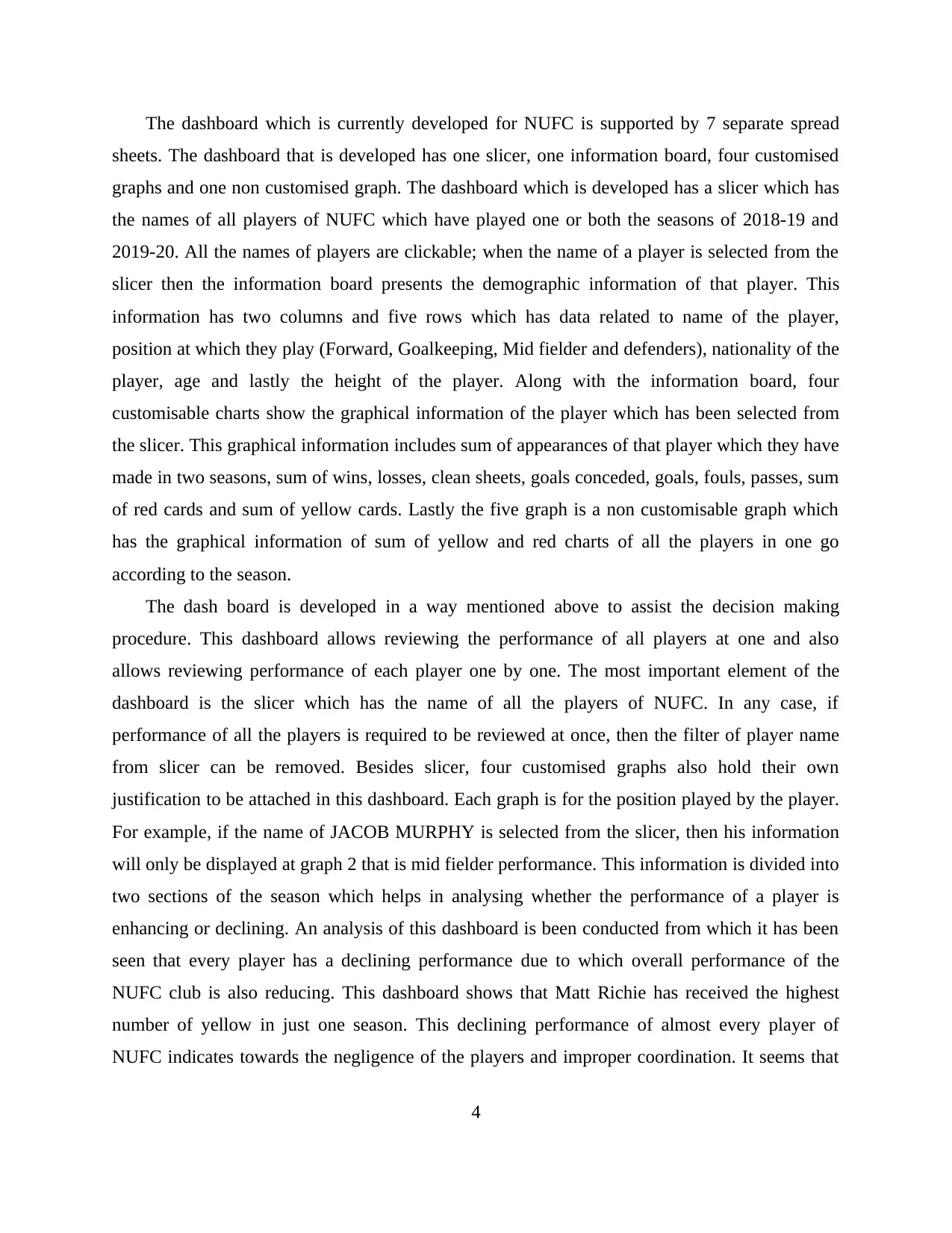
The dashboard which is currently developed for NUFC is supported by 7 separate spread
sheets. The dashboard that is developed has one slicer, one information board, four customised
graphs and one non customised graph. The dashboard which is developed has a slicer which has
the names of all players of NUFC which have played one or both the seasons of 2018-19 and
2019-20. All the names of players are clickable; when the name of a player is selected from the
slicer then the information board presents the demographic information of that player. This
information has two columns and five rows which has data related to name of the player,
position at which they play (Forward, Goalkeeping, Mid fielder and defenders), nationality of the
player, age and lastly the height of the player. Along with the information board, four
customisable charts show the graphical information of the player which has been selected from
the slicer. This graphical information includes sum of appearances of that player which they have
made in two seasons, sum of wins, losses, clean sheets, goals conceded, goals, fouls, passes, sum
of red cards and sum of yellow cards. Lastly the five graph is a non customisable graph which
has the graphical information of sum of yellow and red charts of all the players in one go
according to the season.
The dash board is developed in a way mentioned above to assist the decision making
procedure. This dashboard allows reviewing the performance of all players at one and also
allows reviewing performance of each player one by one. The most important element of the
dashboard is the slicer which has the name of all the players of NUFC. In any case, if
performance of all the players is required to be reviewed at once, then the filter of player name
from slicer can be removed. Besides slicer, four customised graphs also hold their own
justification to be attached in this dashboard. Each graph is for the position played by the player.
For example, if the name of JACOB MURPHY is selected from the slicer, then his information
will only be displayed at graph 2 that is mid fielder performance. This information is divided into
two sections of the season which helps in analysing whether the performance of a player is
enhancing or declining. An analysis of this dashboard is been conducted from which it has been
seen that every player has a declining performance due to which overall performance of the
NUFC club is also reducing. This dashboard shows that Matt Richie has received the highest
number of yellow in just one season. This declining performance of almost every player of
NUFC indicates towards the negligence of the players and improper coordination. It seems that
4
sheets. The dashboard that is developed has one slicer, one information board, four customised
graphs and one non customised graph. The dashboard which is developed has a slicer which has
the names of all players of NUFC which have played one or both the seasons of 2018-19 and
2019-20. All the names of players are clickable; when the name of a player is selected from the
slicer then the information board presents the demographic information of that player. This
information has two columns and five rows which has data related to name of the player,
position at which they play (Forward, Goalkeeping, Mid fielder and defenders), nationality of the
player, age and lastly the height of the player. Along with the information board, four
customisable charts show the graphical information of the player which has been selected from
the slicer. This graphical information includes sum of appearances of that player which they have
made in two seasons, sum of wins, losses, clean sheets, goals conceded, goals, fouls, passes, sum
of red cards and sum of yellow cards. Lastly the five graph is a non customisable graph which
has the graphical information of sum of yellow and red charts of all the players in one go
according to the season.
The dash board is developed in a way mentioned above to assist the decision making
procedure. This dashboard allows reviewing the performance of all players at one and also
allows reviewing performance of each player one by one. The most important element of the
dashboard is the slicer which has the name of all the players of NUFC. In any case, if
performance of all the players is required to be reviewed at once, then the filter of player name
from slicer can be removed. Besides slicer, four customised graphs also hold their own
justification to be attached in this dashboard. Each graph is for the position played by the player.
For example, if the name of JACOB MURPHY is selected from the slicer, then his information
will only be displayed at graph 2 that is mid fielder performance. This information is divided into
two sections of the season which helps in analysing whether the performance of a player is
enhancing or declining. An analysis of this dashboard is been conducted from which it has been
seen that every player has a declining performance due to which overall performance of the
NUFC club is also reducing. This dashboard shows that Matt Richie has received the highest
number of yellow in just one season. This declining performance of almost every player of
NUFC indicates towards the negligence of the players and improper coordination. It seems that
4
⊘ This is a preview!⊘
Do you want full access?
Subscribe today to unlock all pages.

Trusted by 1+ million students worldwide
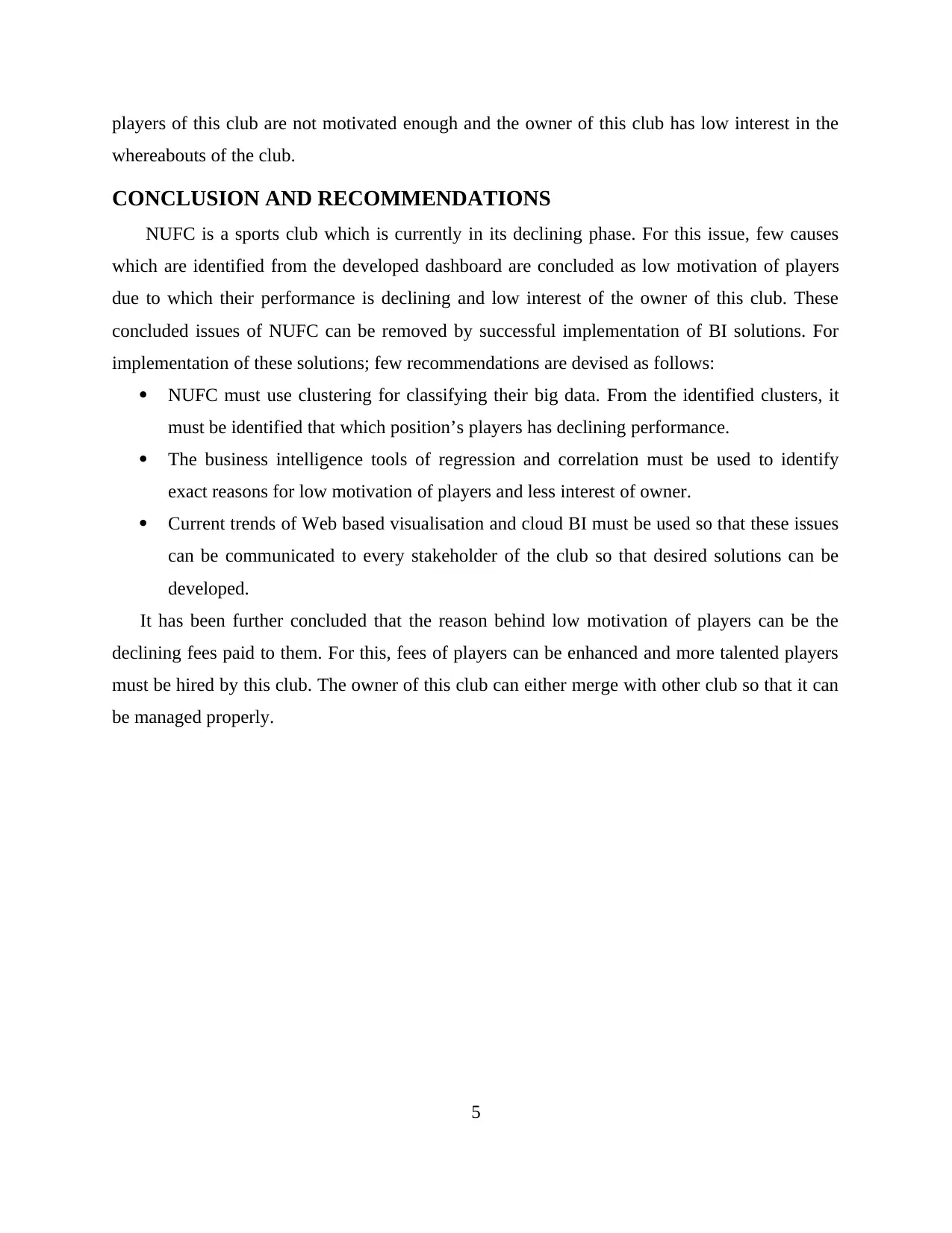
players of this club are not motivated enough and the owner of this club has low interest in the
whereabouts of the club.
CONCLUSION AND RECOMMENDATIONS
NUFC is a sports club which is currently in its declining phase. For this issue, few causes
which are identified from the developed dashboard are concluded as low motivation of players
due to which their performance is declining and low interest of the owner of this club. These
concluded issues of NUFC can be removed by successful implementation of BI solutions. For
implementation of these solutions; few recommendations are devised as follows:
NUFC must use clustering for classifying their big data. From the identified clusters, it
must be identified that which position’s players has declining performance.
The business intelligence tools of regression and correlation must be used to identify
exact reasons for low motivation of players and less interest of owner.
Current trends of Web based visualisation and cloud BI must be used so that these issues
can be communicated to every stakeholder of the club so that desired solutions can be
developed.
It has been further concluded that the reason behind low motivation of players can be the
declining fees paid to them. For this, fees of players can be enhanced and more talented players
must be hired by this club. The owner of this club can either merge with other club so that it can
be managed properly.
5
whereabouts of the club.
CONCLUSION AND RECOMMENDATIONS
NUFC is a sports club which is currently in its declining phase. For this issue, few causes
which are identified from the developed dashboard are concluded as low motivation of players
due to which their performance is declining and low interest of the owner of this club. These
concluded issues of NUFC can be removed by successful implementation of BI solutions. For
implementation of these solutions; few recommendations are devised as follows:
NUFC must use clustering for classifying their big data. From the identified clusters, it
must be identified that which position’s players has declining performance.
The business intelligence tools of regression and correlation must be used to identify
exact reasons for low motivation of players and less interest of owner.
Current trends of Web based visualisation and cloud BI must be used so that these issues
can be communicated to every stakeholder of the club so that desired solutions can be
developed.
It has been further concluded that the reason behind low motivation of players can be the
declining fees paid to them. For this, fees of players can be enhanced and more talented players
must be hired by this club. The owner of this club can either merge with other club so that it can
be managed properly.
5
Paraphrase This Document
Need a fresh take? Get an instant paraphrase of this document with our AI Paraphraser
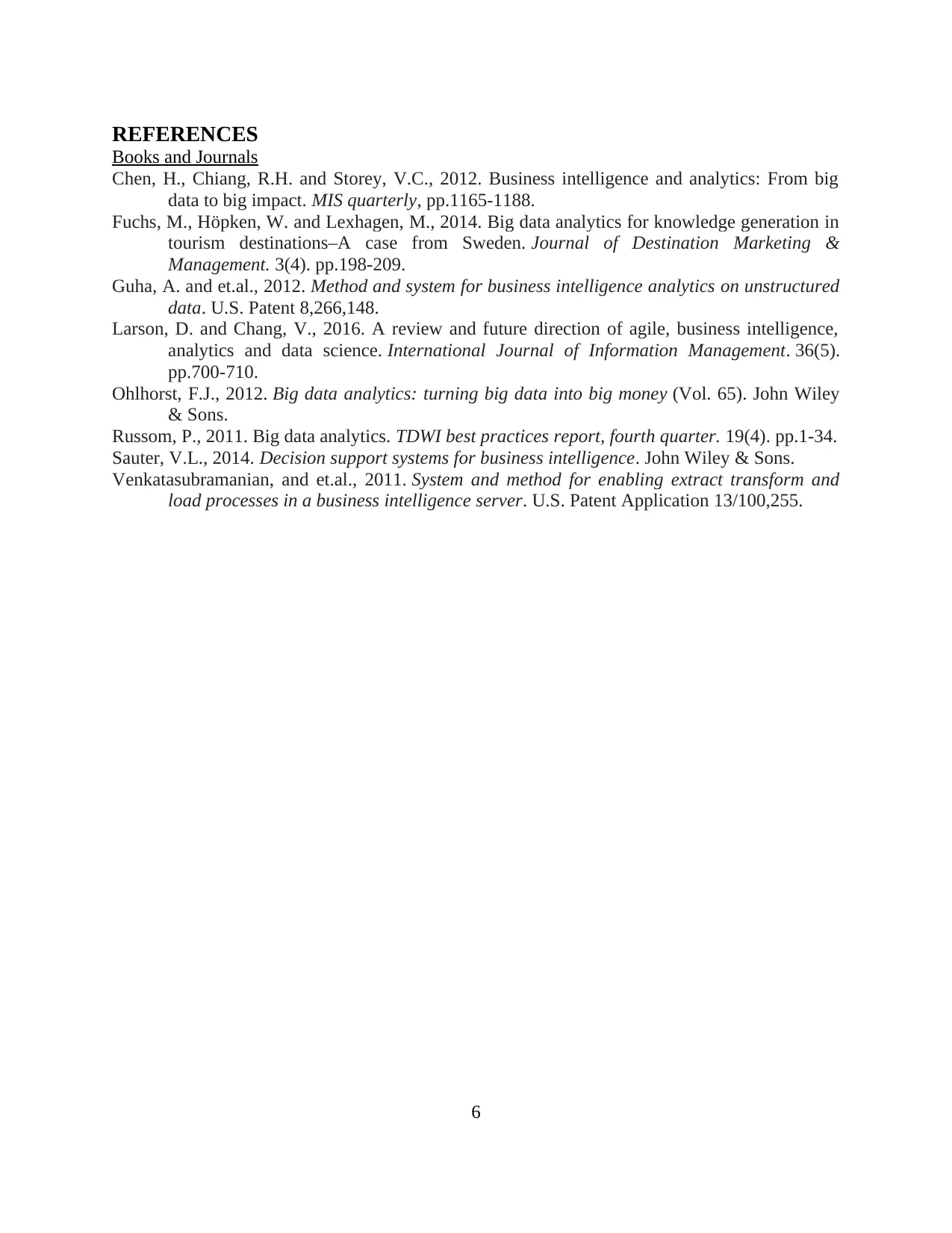
REFERENCES
Books and Journals
Chen, H., Chiang, R.H. and Storey, V.C., 2012. Business intelligence and analytics: From big
data to big impact. MIS quarterly, pp.1165-1188.
Fuchs, M., Höpken, W. and Lexhagen, M., 2014. Big data analytics for knowledge generation in
tourism destinations–A case from Sweden. Journal of Destination Marketing &
Management. 3(4). pp.198-209.
Guha, A. and et.al., 2012. Method and system for business intelligence analytics on unstructured
data. U.S. Patent 8,266,148.
Larson, D. and Chang, V., 2016. A review and future direction of agile, business intelligence,
analytics and data science. International Journal of Information Management. 36(5).
pp.700-710.
Ohlhorst, F.J., 2012. Big data analytics: turning big data into big money (Vol. 65). John Wiley
& Sons.
Russom, P., 2011. Big data analytics. TDWI best practices report, fourth quarter. 19(4). pp.1-34.
Sauter, V.L., 2014. Decision support systems for business intelligence. John Wiley & Sons.
Venkatasubramanian, and et.al., 2011. System and method for enabling extract transform and
load processes in a business intelligence server. U.S. Patent Application 13/100,255.
6
Books and Journals
Chen, H., Chiang, R.H. and Storey, V.C., 2012. Business intelligence and analytics: From big
data to big impact. MIS quarterly, pp.1165-1188.
Fuchs, M., Höpken, W. and Lexhagen, M., 2014. Big data analytics for knowledge generation in
tourism destinations–A case from Sweden. Journal of Destination Marketing &
Management. 3(4). pp.198-209.
Guha, A. and et.al., 2012. Method and system for business intelligence analytics on unstructured
data. U.S. Patent 8,266,148.
Larson, D. and Chang, V., 2016. A review and future direction of agile, business intelligence,
analytics and data science. International Journal of Information Management. 36(5).
pp.700-710.
Ohlhorst, F.J., 2012. Big data analytics: turning big data into big money (Vol. 65). John Wiley
& Sons.
Russom, P., 2011. Big data analytics. TDWI best practices report, fourth quarter. 19(4). pp.1-34.
Sauter, V.L., 2014. Decision support systems for business intelligence. John Wiley & Sons.
Venkatasubramanian, and et.al., 2011. System and method for enabling extract transform and
load processes in a business intelligence server. U.S. Patent Application 13/100,255.
6
1 out of 8
Related Documents
Your All-in-One AI-Powered Toolkit for Academic Success.
+13062052269
info@desklib.com
Available 24*7 on WhatsApp / Email
![[object Object]](/_next/static/media/star-bottom.7253800d.svg)
Unlock your academic potential
Copyright © 2020–2026 A2Z Services. All Rights Reserved. Developed and managed by ZUCOL.





